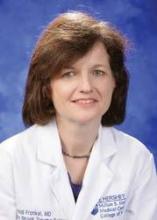Ultrasound, a technology that was once mainly in the purview of radiologists, is becoming an integral part of the surgeon’s toolbox.
Across specialties, an increasing number of surgeons are incorporating ultrasound into their practices, whether in the office or in the operating room, especially as procedures become less invasive.
The once-cumbersome machines have gotten smaller over the past three decades, the technology has improved dramatically, and – compared with some other types of imaging – ultrasound is more cost-effective and affordable, experts say.
"It’s a technology that I think is going to expand in use," said Dr. Jay K. Harness, an early adopter of ultrasound in breast surgery and coauthor of the textbook "Ultrasound in Surgical Practice." "I started using it in the 1990s, and it’s like we’ve gone from analog TV to digital."
Dr. Heidi Frankel, chair of American College of Surgeons’ (ACS) National Ultrasound Faculty, compared the developments in use of ultrasound in surgery to laparoscopy.
"Ultimately, the patients and the market pushed the need for it," said Dr. Frankel, professor of surgery at University of Maryland Shock Trauma Center, Baltimore. "Surgeons who didn’t do it had to learn to do it, and it became part of surgical training. I suspect the same thing is going to happen with ultrasound."
And while training and certification requirements vary widely, the surgeons currently using ultrasound predict that guidelines may ultimately become somewhat standardized within and across specialties.
Breast Surgery
Dr. Harness, who is also a member of the ACS National Ultrasound Faculty and the past-president of the American Society of Breast Surgeons (ASBS), was among the first to incorporate ultrasound into his practice. Today, he said, "for the contemporary breast surgeon, [ultrasound] is a fundamental tool ... Ultrasound is our stethoscope."
In breast surgery, ultrasound is an adjunctive tool for the physical exam, said Dr. Harness. It is used for diagnostic biopsy, and it can speed up the diagnostic process. Ultrasound also is used in the operating room, notably for procedures such as lumpectomies. And finally, ultrasound can help guide the placement of partial breast brachyradiation therapy devices.
Breast surgeons can obtain ultrasound certification through ASBS, although becoming certified is not a requirement. "A major goal of the Society’s breast ultrasound certification program is to improve the quality of care for patients with breast disease by encouraging education and training to advance expertise and clinical competency for surgeons who use ultrasound and ultrasound-guided procedures in their practices," according to the ASBS website.
Dr. Harness said that ultrasound combined with other imaging techniques such as MRI provides the most complete imaging possible, given that there’s no single technology that captures everything.
Abdominal Surgery
In the 1980s, not many surgeons used ultrasound in their day-to-day practice and there were few publications on the topic, said Dr. Junji Machi. At that time, x-rays were commonly used to check areas such as the bile duct for stones. "But, it was cumbersome and took 15-30 minutes. So we used ultrasound instead. It was quicker, and the results were accurate," said Dr. Machi, professor of surgery at University of Hawaii, and director of the Abdominal Ultrasound Module at the ACS.
Dr. Machi has published a number of studies on cases and findings, and he uses ultrasound, especially during liver, biliary, and pancreatic surgery.
"For liver surgery, intraoperative ultrasound is a must," he said. "Without it, we consider the procedure suboptimal, because we may miss lesions and cannot perform the best operations."
Among the indications for ultrasound use in abdominal surgery were laparoscopic procedures, which were introduced in the 1990s, he said. "You can see, but not touch, the tissue," said Dr. Machi. "So we needed something to evaluate under the surface. ... With ultrasound, we can see without much dissection."
Surgeons could be discouraged from using ultrasound because the learning curve is steep (usually several months’ experience is needed) and because the equipment is relatively expensive. Yet, "once you learn it, it’s much more cost effective," he said, adding that this imaging technique does not expose the patient and operative team to radiation.
There’s no specialty limitation in the use of ultrasound, and abdominal surgeons can perform it once they master ultrasound. The ACS ultrasound course is an excellent way to learn, said Dr. Machi. Surgeons receive a certificate upon completion of a course.
Indeed, "the training issues are really paramount," said Dr. Ellen Hagopian, who did her liver training in France, and studied with radiologists and surgeons. Ultrasound is used much more frequently in Europe than in the United States, she said. "I sit on the education and training committee of Americas Hepato-Pancreato-Biliary Association [AHPBA], and I think ultrasound training throughout the fellowship programs needs to be more consistent."


